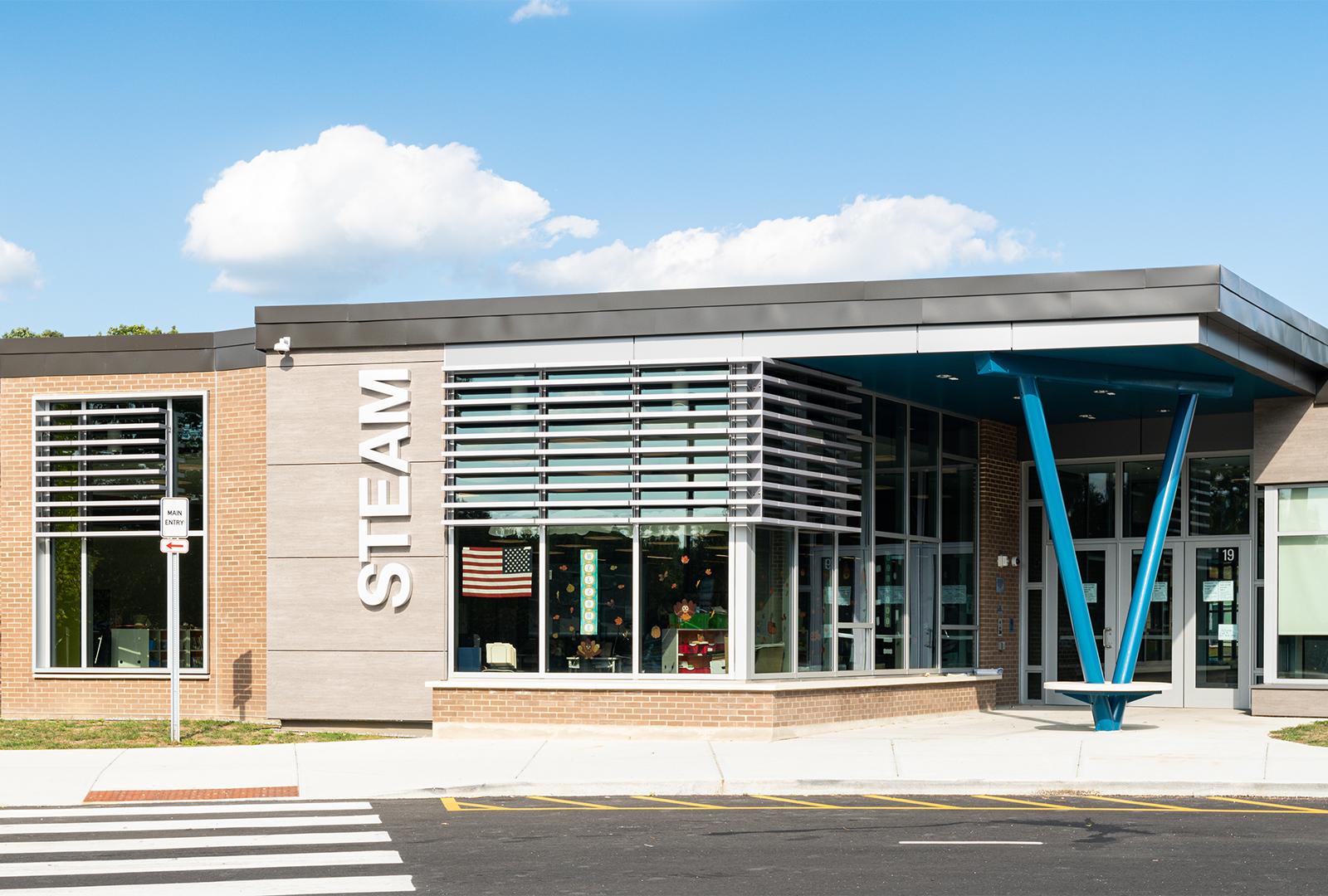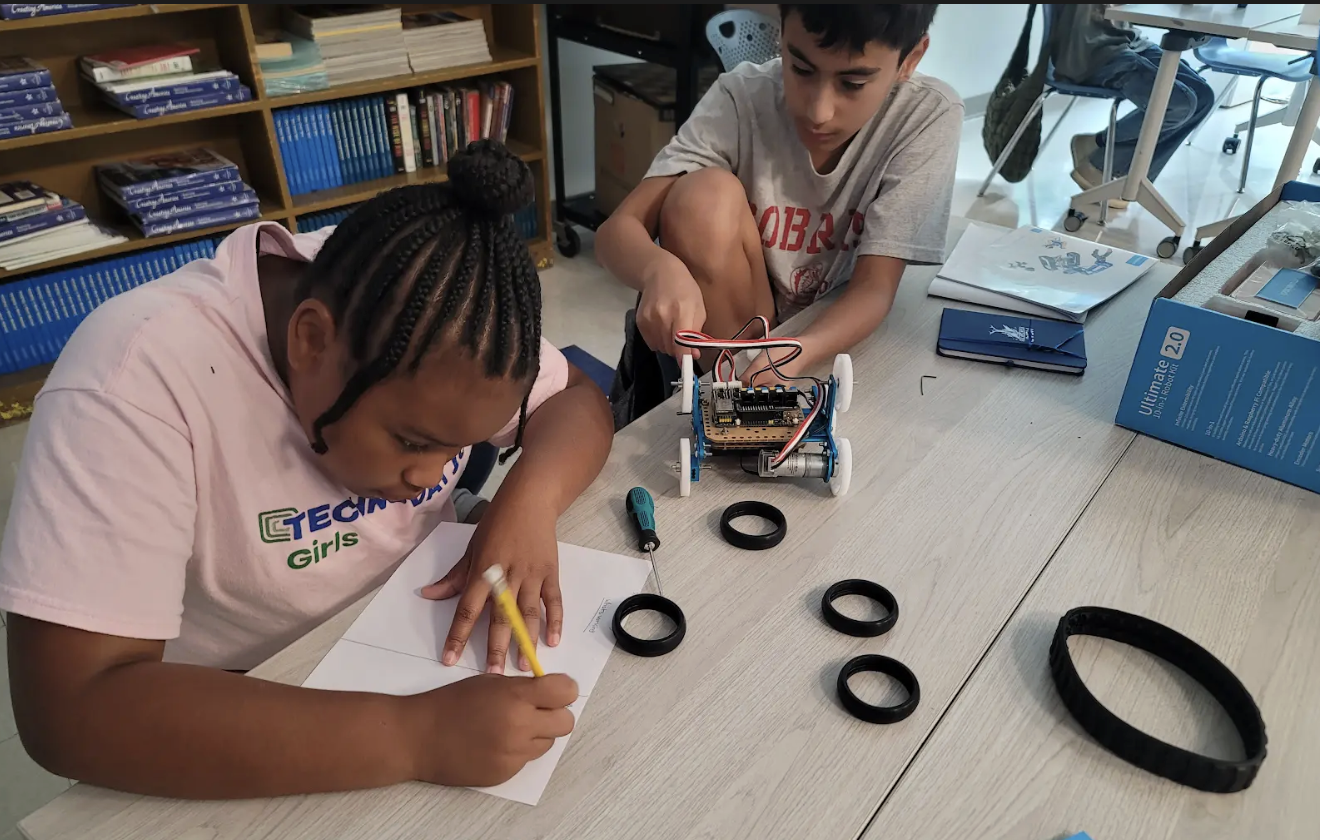
We had the opportunity to speak with Dr. Damon Christopher Lewis, principal of Ponus Ridge STEAM Academy in Norwalk, Connecticut. Recently honored as the 2025 Connecticut and National Middle School Principal of the Year, he calls the recognition a “we award,” reflecting a schoolwide commitment to equity, Project Based Learning, and community partnership.
PBLWorks: Tell us a little about yourself and your journey into school leadership.
Dr. Lewis: I’ve been the principal of Ponus Ridge STEAM Academy in Norwalk, Connecticut, for 11 years. Before that, I served as assistant principal at Ponus for four years. I have worked in the same building for 15 years. Earlier in my career, I taught high school English and later worked as a school counselor. Both roles provided me with a deep appreciation and understanding for the many different angles of supporting students and families

PBLWorks: You’ve just been named the 2025 Connecticut and National Middle School Principal of the Year. What does this recognition mean to you?
Dr. Lewis: Being honored this year is humbling, and to me it is a WE award. None of this work happens alone. It’s been a truly collaborative and uplifting experience as I work in a district, headed by Dr. Alexandra Estrella, that is unafraid to build capacity in leaders. Additionally, I work with some of the most talented practitioners in the profession. Their attention to detail, while providing students and families with opportunities, is unmatched!
I believe educators are change agents. We’re literally saving lives. And for our school, Project Based Learning (PBL) has been a key driver of that change.
PBLWorks: What is your school’s vision for PBL?
Dr. Lewis: For us, PBL is about creating a true community of learners. We wanted to move away from the traditional model of standards on the board and objectives for the day, and instead bring kids into hands-on, authentic learning experiences. While practitioners still are required to post their BIG THREE - Standard(s), Objective(s), and Criteria for Success, the “work” happens while kids work in groups, problem solve, critically think, and effectively communicate. Our staff knows we are building the NEXT generation of leaders! Our school is 90% students of color, with about 70% qualifying for free or reduced lunch.
PBL has been a game changer in giving our students access and opportunity. They’re motivated, engaged, and working collaboratively in ways we didn’t see before.
Our kids engage in real-world activities. That engagement helps students see themselves in the teaching and learning process as active learners and participants.
PBLWorks: How did you and your school begin your PBL journey?
Dr. Lewis: We were fortunate to be recipients of a Magnet Schools Assistance Program (MSAP) grant. Our project manager, Dr. Victor Black, introduced me to PBL. He had experience implementing it and showed me how powerful it could be. He convinced me, and then it became my job to bring our staff along.
We started small. A core group of five or six teachers formed a PBL team under the direction of Mrs. Colleen Brosnan, one of our assistant principals. They attended PD sessions, “tested the waters” and then shared their ideas/projects in faculty meetings. As we progressed, other teachers could visit “stations” during faculty meetings to see and hear the implementation strategies of the PBL team. That incremental approach made the shift manageable. I always say: change is good, but it’s better when it’s done incrementally.
PBLWorks: Can you share a project that really stood out to you?
Dr. Lewis: One of our first big projects was a sixth-grade tourism challenge. As noted previously, this is a WE award and all credit for this project goes to Mrs. Julie Hartley and Dr. Brian DeBoer. Students were asked: How can we design and market an island destination that captivates travelers and stands out in the global tourism industry?
They conducted market research, created maps, analyzed resources, designed websites, and even used AI tools and coding. Authentic audience members such as travel agents and web developers, were invited to Ponus to give feedback to students so their projects could be revised and improved. Additionally, kids were provided with multiple opportunities to provide peer to peer feedback as well.
It checked every box of the Gold Standard PBL model: sustained inquiry, authenticity, student voice and choice, and a public product. And the students loved it. They didn’t just learn about history and economics; they applied those concepts in meaningful ways. Kids were talking in the hallways and at home about what they were building. They weren’t just memorizing; they were applying history, economics, and technology in meaningful ways.
PBL is rigorous as students, at times, don’t see PBL as learning as they are having fun simultaneously. In my opinion, PBL, when implemented with and planned with intentionality, is more rigorous than traditional approaches. Staff and students are integrating disciplines and students delve into deeper levels of questioning and inquiry. As a result, students are constructing their own understanding through the process. That’s where the magic happens.
PBLWorks: What changes have you seen in teachers as they’ve embraced PBL?
Dr. Lewis: At first, some teachers were hesitant. But as soon as they saw the difference in student engagement, they were all in. Teachers who used to feel drained at the end of the day now tell me they go home with more energy because students are doing the heavy lifting. We focus on creativity, integration, and collaboration. Yes, we still have district curricula, and staff are discovering ways to enrich the curricula through PBL experiences for students. PBL, coupled with student engagement have been the driver for our Portrait of a Graduate work around developing students as critical thinkers, and effective communicators.
PBLWorks: Chronic absenteeism at your school dropped dramatically. How did you make that shift, and how does PBL play a role?
Dr. Lewis: After the pandemic, our absenteeism rate was about 31%. We drew a line in the sand—created an attendance team, involved homeroom teachers, emailed home, sent letters, involved outside agencies and made home visits. That alone helped us drop to 8.8% in one year. As noted, I see educators as life savers with education being the great equalizer. Our staff feels obligated to “go and get kids”. For chronic absenteeism, anything under 10% is considered GREAT! Ponus was at 7.7% in May, 2025, and finished the year above 8.0%. The attendance team meets bi-weekly and is facilitated by Mr. Evan Byron, an assistant principal at Ponus. He is joined by the school counselors and the social worker.
What also made the difference was when students started experiencing PBL. They wanted to be here. They didn’t want to miss projects or presentations. After-school programs were also built around PBL, such as robotics and STEAM clubs, which provided additional motivation for students to attend school. Currently, we have over 20 after school clubs that students can join. We make our school attractive so families want to attend. We currently have a waiting list of approximately 20 families who wish to attend Ponus Ridge. Attendance improved because learning became something they looked forward to.

PBLWorks: Equity has been a strong focus at Ponus Ridge. How has PBL helped expand access and opportunity?
Dr. Lewis: Equity is at the core of our work. We’ve set schoolwide equity goals - increasing Latinx and Black student representation in our Gifted and Talented program, while also increasing the number of female students in accelerated math. We’ve achieved those goals. BIG SHOUT OUT to the administrative team at Ponus Ridge: Evan Byron, Colleen Brosnan, Ashley Glaude, and Maryann Murillo. WE all do this work to support students and families. They are truly the change agents in the building!
PBL is a “stereotype disrupter”. Too often people say Black and Brown students are not capable of handling rigorous coursework, and that students cannot be “trusted” to perform the heavy lift in the classroom. Gradual release of responsibility is PBL crafted.
Walk into a classroom at Ponus, and you’ll see 90% students of color building robots, designing prototypes, creating websites, coding, presenting to real-world audiences, and taking computer science courses. They’re not just participating, they’re thriving. This is life-changing work. And I say that personally. I was the achievement gap. I went to college far behind in some areas despite being a top student in high school. I don’t want our kids to have that same experience. PBL gives them the skills and mindsets to succeed beyond school, to attend college or whatever they pursue next. They will be ready and confident.
PBLWorks: How has PBL helped you engage with your community?
Dr. Lewis: Every first Wednesday of the month, we host Walkthrough Wednesdays. We open our doors to families, community members, and even elementary parents considering our school. They see real classrooms, in real time, with students fully engaged in projects and grade level TASKs. That transparency has built incredible community trust. Our learning community is not hesitant to open our doors so anyone can come to experience the Ponus experience. We operate in a bell-less building. You will never hear a bell ring in our community. Families want to be part of what we’re building at Ponus, and PBL has been a huge lever.
PBLWorks: What’s your vision for the next phase of your PBL journey?
Dr. Lewis: I’m a visionary thinker. Right now, we’re already a bell-free school. My dream is to move toward wall-free classrooms. Imagine 60 kids and five teachers in one large space, rotating between stations, collaborating across disciplines, and spending extended blocks of time communicating, critically thinking, revising, and being an active participant in their learning. There is nothing passive about PBL! Yes, it’s messy. But messy is where the learning happens. That’s where engagement and rigor live and growth happens for students and staff!
PBLWorks: What advice would you offer to new principals considering PBL?
Dr. Lewis: As a new principal, I always say we’ve been blessed with two eyes, two ears, and one mouth, so listen and observe twice as much as you talk. Additionally, I would advise new principals to start their PBL journey with three or four teachers who are ready to dive in and let their success help bring others along. Remember, it’s about progress, not perfection. Just focus on getting better every day. PBL is going to be messy at first, and our students are worth it. I would advise them not to compromise their core values. Your core values should be the same at home, at school, and in the community.
Above all, be present. Leadership doesn’t happen in the office. It lives in classrooms, cafeterias, and alongside teachers, students, and families.
PBLWorks: Is there a principal you’d like to honor during National Principals Month?
Dr. Lewis: Two come to mind. First, Dr. Edward Goldstone, my principal at Harding High School in Bridgeport, CT. We began at Harding together in 1986. I was a ninth grader, and he was a first year principal at Harding. Additionally, he was my first boss when I returned as an educator. He taught me humility and the power of “we.”
Second, Ms. Linda Sumpter, who hired me as an assistant principal at Ponus 15 years ago. She identified abilities and skills in me that I didn’t know I had. Both shaped the leader I am today.

